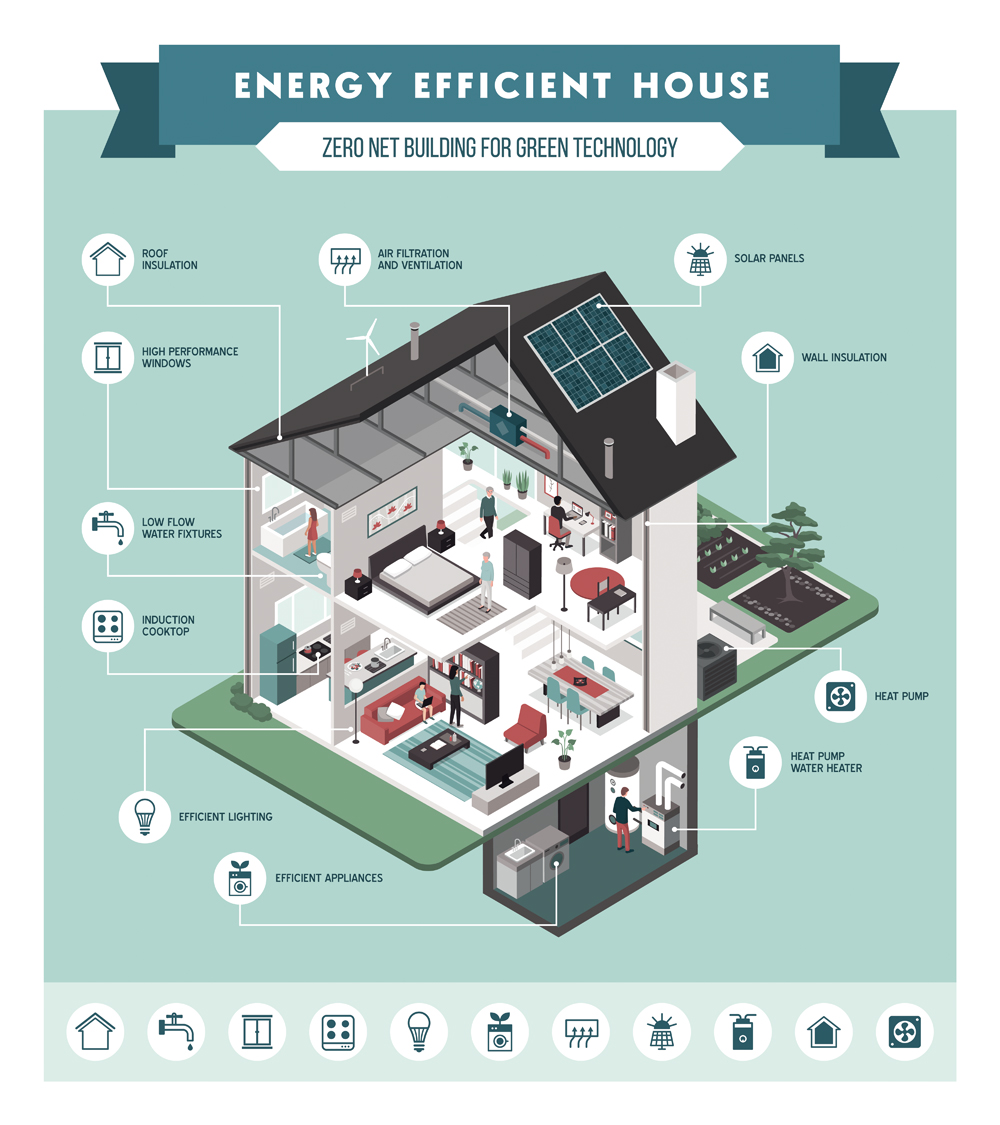Get Retrofit
A Fossil Fuel-Free Building Future
By Melinda McKnight | Winter 2020 | Clean Power Guide
Solar panels, heat pumps, and EV charging stations are signs of the shift toward clean power technologies—and the underlying electrification that makes the system more efficient. This is heartening. But to get us all off fossil fuels, the importance of reducing building energy usage through efficiency upgrades cannot be overstated. Does your building need a retrofit? Here are some of the signs that it might: rooms that are too hot or too cold; high utility bills; Unpleasant odors, stale air, or poor air quality; bubbling or peeling paint; rodents, insects, spiders, or snakes; mildew or mold; heating with dirty energy; icicles or ice dams; frequent illness of the occupants; noise (trains, traffic, or room to room).
What’s a building science-based retrofit and why does it matter?
Building scientists are experts who are accredited by the Building Performance Institute. They apply the laws of physics to understand how air flow, moisture, and systems within a building function together. They can see the signs of an underlying problem in order to treat more than the symptom. They also perform diagnostic testing to implement lasting solutions for healthy, safe, efficient, comfortable, durable, and fossil fuel-free buildings. Without following their guidance to improve efficiency first, building owners can fall prey to bad decision-making like installing heat pumps that are larger, more costly, and less effective at heating and cooling your home; or purchasing solar arrays that are larger and cost more to provide for your electric needs.
What does a building retrofit entail?
A building retrofit begins with an examination of the building, including a visual inspection and diagnostic testing. An essential part of the process is dialog with the property owner to understand any concerns about the indoor environment and to become clear on their goals. Based on the information collected, a scope of work proposal is created that generally includes: removal of old, damaged insulation; ventilation—passive and mechanical; air sealing (top plates, plumbing and electrical penetrations, drywall seams, vent hoses); vapor barrier; new insulation (cellulose, rockwool, closed cell spray foam, or extruded SPF polyisocyanurate) in attics, under floors, walls, and kneewall attics; duct sealing and insulation; and air purification
I already have insulation in my attic and basement. Isn’t that good enough?
The truth is that it depends on the type of insulation, its condition, and if air sealing was performed. Air sealing reduces the ways that air enters or leaves the building. It is important to have some fresh air come into the building, but not so much that you experience drafts and high utility bills. Allowing just the right amount of air to enter and leave your building is key in order to maintain the health of the occupants. Building scientists know how to calculate the Building Airflow Standard for buildings to ensure you maintain proper ventilation.
Most buildings were insulated with fiberglass—pink, yellow, or white. Fiberglass works well inside wall cavities, where it is enclosed between framing, sheathing, and drywall. When fiberglass is used in attics, crawlspaces, or basements, it does not work nearly as well because air passes right through it. This is why it becomes so dirty. The fiberglass filters the air as it enters or leaves your heated living space. Fiberglass is often improperly installed, which can create conditions leading to mold growth or off-gassing due to wood decay. Fiberglass is also an excellent nesting material for rodents and insects as well as the source of dust indoors. These factors can contribute to respiratory issues in children and adults.
Is spray foam the best insulation material?
If you are talking about R-value (how much the insulation material resists heat transfer), yes, but only if it is closed-cell spray foam. Closed-cell spray foam has the highest R-Value (R-7 per inch) but it is also the most expensive and not best for all situations. Open-cell spray foam is much less costly than closed-cell spray foam; however, more material is needed for it to perform well. We recommend that open-cell spray foam be used only in commercial buildings, as it can have a long period of off-gassing chemical fumes. This type of foam is also attractive to rodents for nesting material. There are other very effective insulation materials available and choosing the best one for you can only be accomplished by understanding your particular situation, goals, and budget.
DoI need to do it “all at once,” or can I stage the project?
It is possible to accomplish your project any way that best matches your needs and your budget. There are advantages to each. It makes sense to do what works best for you.
How do I achieve a fossil fuel-free, net-zero home?
The first step is to reduce energy consumption. The ways to reduce energy usage include: 1. Switch to LED light bulbs. 2. Install professional air sealing techniques. 3. Upgrade your insulation. 4. Upgrade your hot water heater. 5. Install continuous, professional grade hot water pipe insulation. 6. Invest in Energy Smart appliances.
Once energy consumption is reduced, the next step is to install solar panels (if you can) or to buy solar energy. If you decide to install solar panels, it would be worth considering a back-up storage system to become energy independent. The last step on the journey is to install air source or ground source heat pumps to provide clean comfort all year long.
Melinda McKnight is the EVP at Energy Conservation Services, a Kingston-based home performance contracting firm.

